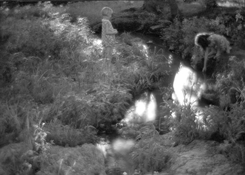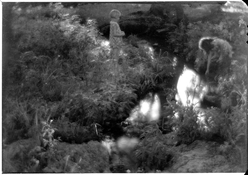ntenny
Subscriber
I’ve inherited some family negatives on nitrate stock, 4x5 through 8x10. They’re in good condition, but I know I can’t rely on them to stay that way, and then there’s the fire danger, so I need to find a way to archive them in a stable and safe format.
I would like to end up with negatives, so I can print from them optically. This may not be practical to do for all the images (there are a few dozen on nitrate), so I may end up keeping scans of the ordinary ones and negatives of the best few.
As far as I can tell, I have three options for producing negatives:
1) pay for drum scans followed by a print-to-film process;
2) do my own darkroom work to contact print them to interpositives, then to duplicate negatives;
3) do my own darkroom work to contact print them into a direct-positive process.
Obviously #1 is the easiest, but it’s prohibitively expensive to use for more than a few sheets. I only found one lab that can do it (BowHaus in Los Angeles).
#3 looks hard. I’ve done a little b&w reversal before, found it fiddly, and never got really good results.
So I’m curious about #2. How hard is it, assuming I’m a competent but not exceptionally detail-oriented LF worker? Past threads have seemed not to have consensus on what film to use (my impression is either pictorial ortho or ortho litho, with film developer), and I don’t know where to start with exposure. I guess I’d like a brief practical guide to this process.
Also, are there any options I’m overlooking—again, assuming I want to end up with negatives?
Thanks
-NT
I would like to end up with negatives, so I can print from them optically. This may not be practical to do for all the images (there are a few dozen on nitrate), so I may end up keeping scans of the ordinary ones and negatives of the best few.
As far as I can tell, I have three options for producing negatives:
1) pay for drum scans followed by a print-to-film process;
2) do my own darkroom work to contact print them to interpositives, then to duplicate negatives;
3) do my own darkroom work to contact print them into a direct-positive process.
Obviously #1 is the easiest, but it’s prohibitively expensive to use for more than a few sheets. I only found one lab that can do it (BowHaus in Los Angeles).
#3 looks hard. I’ve done a little b&w reversal before, found it fiddly, and never got really good results.
So I’m curious about #2. How hard is it, assuming I’m a competent but not exceptionally detail-oriented LF worker? Past threads have seemed not to have consensus on what film to use (my impression is either pictorial ortho or ortho litho, with film developer), and I don’t know where to start with exposure. I guess I’d like a brief practical guide to this process.
Also, are there any options I’m overlooking—again, assuming I want to end up with negatives?
Thanks
-NT







